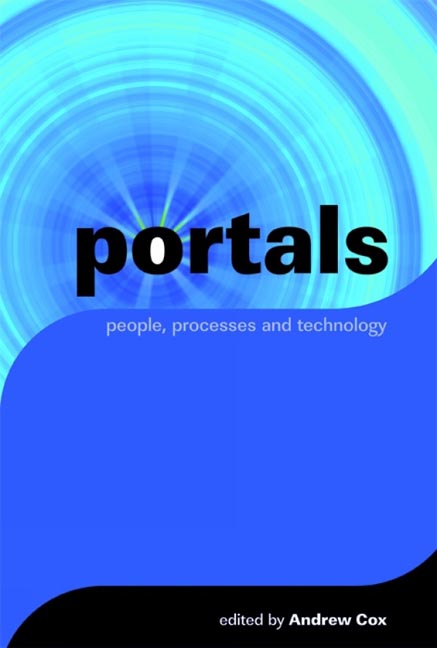Book contents
- Frontmatter
- Contents
- Introductory preface
- Section 1 Core themes
- Section 2 The library and the portal
- Section 3 The portal in the corporate sector
- 10 Information at your fingertips: B2E portal as a strategic tool for today's workforce
- 11 Enterprise information portals
- Section 4 Portals in the public sector
- Section 5 The future
- The contributors
- Index
11 - Enterprise information portals
from Section 3 - The portal in the corporate sector
Published online by Cambridge University Press: 09 June 2018
- Frontmatter
- Contents
- Introductory preface
- Section 1 Core themes
- Section 2 The library and the portal
- Section 3 The portal in the corporate sector
- 10 Information at your fingertips: B2E portal as a strategic tool for today's workforce
- 11 Enterprise information portals
- Section 4 Portals in the public sector
- Section 5 The future
- The contributors
- Index
Summary
Introduction
This chapter describes the functionality and use of enterprise information portals (EIPs). These are applications which integrate structured and unstructured information onto a desktop that can be customized by each user. The concept of EIPs dates back to the late 1990s, but there are now virtually no stand-alone EIP server applications because the EIP vendors that survived the dot.com crash have now been acquired. Although in theory the concept of an enterprise portal providing integrated access to a range of disparate applications is one of considerable utility, in reality EIPs have failed to deliver the anticipated benefits. Nevertheless, individual features of EIPs do have value, but these are now being delivered through broader-based enterprise platforms. There is some encouraging development in portal standards through JSR 168 and WSRP (see below).
Integrating structured and unstructured information
Until the mid-1980s investments in computer power were justified on the basis of providing better access to large structured databases of information. The metric for intellectual property of a company was the size of the computer room sitting behind glass screens in an air-conditioned paradise. Then came the PC! Only people older than about 40 can remember offices where desks were full of paper but there was hardly a computer in sight. Access to corporate computing power was over dumb terminals used by people who did little else all day except enter and retrieve data.
Over the last two decades the volume and scale of unstructured data has increased enormously as everyone becomes their own typist, and the default method of communication seems to have become e-mail. As a result, the general rule of thumb is that 85% of the information in an organization is now unstructured text, e-mail and external business information. Gaining access to this information is a considerable challenge, but an even greater one is the need to gain simultaneous access to both unstructured and structured information through a single user interface and with a standard set of tools.
- Type
- Chapter
- Information
- Portalspeople, processes and technology, pp. 138 - 146Publisher: FacetPrint publication year: 2006

